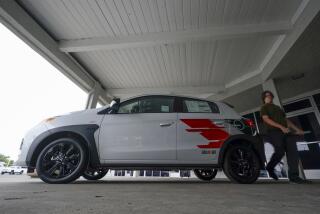Top 10 vehicles that moved us in 2013
Consumer confidence, job growth and low interest rates are fueling the growing and profitable U.S. auto industry, the economic pundits say. We see another reason — great cars.
So we’ve selected our 10 favorite vehicles of 2013. Our list might seem heavy with expensive cars, but it’s not because we’re snobs. We judged only models that were new or redesigned this calendar year — a group that tilted toward luxury and performance vehicles. Among the few new economy cars this year was the Toyota Corolla, which made this list.
Whether you are shopping for a family sedan, a full-size truck or compact crossover, fierce competition has produced a menu of great choices. In testing dozens of vehicles a year, rarely do we come across one we truly hate. Some bore us. Others have irritating features. And certainly some vehicles are much better than others, dominating their respective segments. But the minimum level of quality and performance in today’s cars is high compared with decades past.
PHOTOS: The top 10 vehicles that moved us in 2013
The resurgence of U.S. automakers after the industry’s painful restructuring has only added to the level of competition, challenging German and Japanese automakers to raise their game.
We tend to favor vehicles with comfortable seating, confident steering and easy-to-use controls. We dislike transmissions that don’t follow orders; suspensions that can’t balance ride and handling; and, the most common shortfall, confusing or glitchy electronics. (Note to automakers: Buttons and dials still work in the 21st century, often better than your touchscreens.)
Here is our 2013 list, in alphabetical order, of cars that drove well and accomplished something important for their brand.
Acura MDX: We’ve been underwhelmed by most Acuras lately. But we dig the $43,185 MDX sport utility, a spacious, refined hauler that shines whether you are shepherding six kids to soccer or stuffing the back with Labrador retrievers. The finely tuned steering and suspension avoids the squishy character of many rivals. Two safety systems — active-lane-keeping assist and cruise control — are among the most intuitive in the industry. The 3.5-liter V-6 engine purrs at highway speeds and has plenty of power for on-ramps and passing. Put it all together and you have an uncommon combination of luxury, utility, safety and value.
Chevrolet Corvette Stingray: This seventh-generation Corvette starts at $50,595 and may be the best vehicle made in America right now. The 6.2-liter V-8 has endless power — and a zero-to-60 mph time of 3.8 seconds. Things get even better with the C7’s seven-speed manual gearbox, which lets the driver make the most of 455 horsepower and 460 pound-feet of torque. Even so, the newest Corvette gets a surprising 29 mpg on the highway, thanks in part to a system that deactivates four of its eight cylinders at cruising speeds. Inside, the cabin is a marked improvement over the Kmart special that was in the C6. The steering feels firm and certain, almost as if it is divining the road’s innermost secrets.
Honda Accord Hybrid: The Accord sets a new standard for hybrids, with a groundbreaking blend of comfort, performance and efficiency. Starting at $29,945, it costs only slightly more than a Toyota Prius — and matches its efficiency in a better-looking, better-equipped, more powerful, full-sized sedan. EPA rating: 50 city, 45 highway. We had no trouble matching those figures in a real-world test. Just for fun, we tried to maximize the mileage with careful driving — and hit 60 mpg over two hours on flat city streets. Seriously. No joke. We are talking about a luxurious 3,600-pound sedan that can turn zero-to-60 mph in seven seconds.
Jaguar F-Type: The F-Type, the spiritual successor to the legendary E-Type, could hardly mean more as a symbol of Jaguar’s nascent comeback. And you could hardly imagine a prettier symbol — do yourself a favor and stare at this thing for a while. A mere photograph of this voluptuous drop-top might have landed it on our favorites list. But the handling on the mid-level version we tested was as good as its looks — and sounded even better, with a supercharged 3.0 V-6. The top-line V-8 convertible no doubt sounds even more ferocious while ripping through four-second zero-to-60 mph runs. The $69,895 F-Type provides hope that Jaguar might regain some of its E-Type-like swagger, last seen in the 1960s.
Lexus IS 350: Toyota’s luxury division puts out solid, well-appointed cars that are typically boring. The new $36,845 Lexus IS 350 breaks that pattern. Remove the logo and you might mistake this aggressive sports sedan for something from Germany. From the side, the IS is sleek, with a long hood. In front, lines of the grille flow across the hood, presenting a sense of movement with a hint of menace. The elegant interior boasts the precision fit and finish you expect from Japanese automakers. The IS 350 pairs a 3.5-liter V-6 with an eight-speed automatic transmission to provide sports-car acceleration. The car is stiff, connected to the road with nimble steering. Don’t cheap out and opt for the lessor IS 250. A smaller engine and cost-cutting considerations in that model hand the advantage back to the Germans.
Mazda6: This is the cool guy’s family sedan. Mazda makes its car distinctive in what typically is a boring slice of the car market by wrapping a sleek, handsome shell around the best-handling sedan in its class. When it comes to fuel economy, the $21,785 Mazda6 is one of the stingiest non-hybrid mid-size sedans available, getting up to 28 mpg in the city and 40 mpg on the highway. This is a car that should give you the confidence to walk away from that Toyota Camry and live a little.
Mercedes-Benz S550: Mercedes has a long history of using the S-Class to introduce technologies that later become commonplace in common cars — air bags and anti-lock brakes, for instance. This all-new model keeps up the tradition. A camera system reads road conditions and adjusts the air suspension accordingly, and 360 degrees of radar can spot hazards, both motorized and human. This car doesn’t even have light bulbs. Anywhere. Instead, some 500 LEDs are used inside and out. What hasn’t changed is the pampering of S-Class passengers, who enjoy acres of curved wood, massaging seats — and even perfumed air, if that’s your thing. Meanwhile, a silky twin-turbocharged V-8 moves this $93,825 sedan from zero to 60 in 4.8 seconds.
Porsche Cayman: You might think Porsche has lost its focus on sports cars, given the automaker’s plans for a second crossover and a $845,000 hybrid supercar. The Cayman refutes such notions. With a mid-mounted six-cylinder boxer engine cranking out 275 horsepower, and a blissfully precise and smooth manual transmission, this is Porsche purity like its founders intended. Starting at $53,595, it looks the part, too: poised, sleek and athletic. This is the recipe that defines Porsche, and the Cayman pulls it off with grace.
Tesla Model S: This Tesla Model S has spurred a thorough rethinking of the electric car. With the biggest available battery, the Model S has an EPA-rated range of 265 miles — more than three times most electrics. It charges from zero to 60 mph in a scant 5.4 seconds — 4.2 seconds in the performance version. The massive touchscreen could have been designed by Apple. Revolutions don’t come cheap, as this car starts at a cool $71,079 before any government incentives and climbs quickly to six figures. But for that coin, you get a car that can more than hold its own against an Audi A7 turbo-diesel (which almost made this list). And Audi has been making cars for decades.
Toyota Corolla: We did not expect to like this car. Historically, the Corolla has often been the car for people who don’t like cars, the ultimate A-to-B appliance. Cheap. Dependable. Ugly. Toyota wouldn’t put it quite that way, but the automaker has acknowledged a certain lack of flair in the styling and driving dynamics of its cars. The $17,610 Corolla is among the first model redesigns Toyota has vowed would inject excitement into the brand — and it delivers. This is a distinctive and handsome car, inside and out. It handles well while retaining a comfortable ride. It has enough power. Even the fuel-efficient and gearless CVT transmission responds intuitively to actual driving, as opposed to just getting there.
Follow our daily automotive coverage at latimes.com/business/autos









